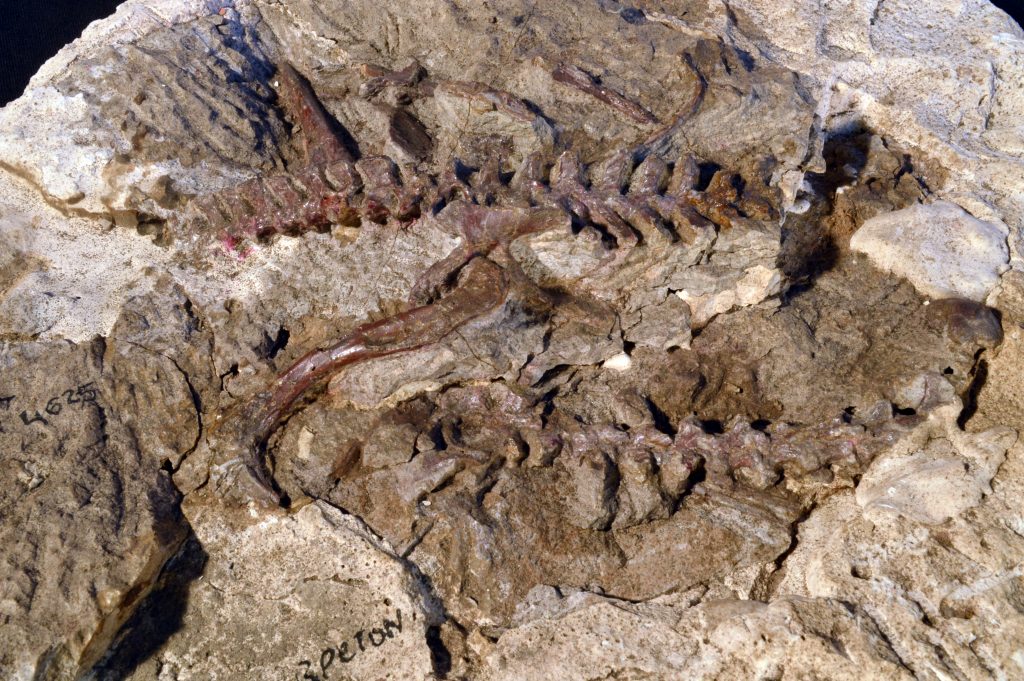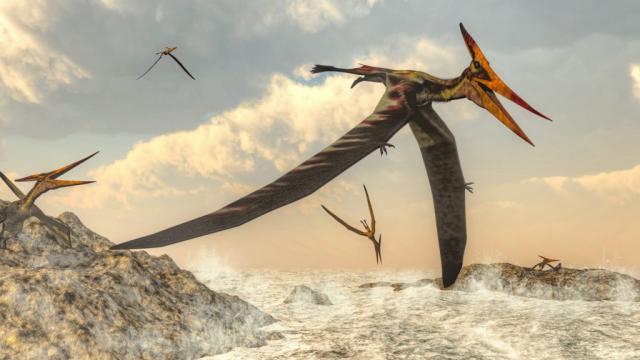Pterosaurs are among the most recognisable creatures from the dinosaur age, yet scientists know very little about their origins. New research finally pinpoints a possible precursor to these flying reptiles.
Pterosaurs — the first vertebrates to evolve powered flight — were a wildly successful group of flying reptiles, emerging some 150 million years ago and expiring 66 million years ago during the Cretaceous–Paleogene mass extinction. Since the 19th century, however, paleontologists have struggled to craft their origin story, leaving it a mystery as to how these creatures evolved the capacity for flight.
No non-pterosaur group has confidently been linked to them, but that’s changed owing to new research published today in Nature. An exhaustive analysis of fossils found in North America, Brazil, Argentina, and Madagascar suggests pterosaurs are descended from largerpetids — an enigmatic group of small reptiles that lived during the Triassic period.
Consequently, this finding “provides a new framework” for studying the origins of pterosaurs, including their “specialised body plan and flying abilities,” according to the paper, co-authored by paleontologist Martin Ezcurra from the University of Birmingham and the Argentine Museum of Natural Sciences. Scientists Sterling Nesbitt and Michelle Stocker from Virginia Tech also contributed to the new work.

Largerpetids lived between 237 million and 210 million years ago, and most were small, measuring less than 3 feet (1 metre) in length. Paleontologists aren’t sure if they walked on four legs or two, but as the new study proposes, their claws were likely used for activities other than locomotion on land, such as climbing or catching prey. Largerpetids had long, thin legs, and they probably ate bugs. Only six species of largerpetids are known, two from Argentina, two from the United States, and the remainder from Brazil and Madagascar. Notable examples include Dromomeron gregorii from the U.S. and Ixalerpeton brasiliensis from Brazil. Importantly, largerpetids were not dinosaurs, as they lacked the required hips and ankles.
These creatures seem an unlikely sister group from which pterosaurs emerged, which is probably why they’ve been ignored for so long. Recent analyses of largerpetids hinted at the possibility, prompting Ezcurra and an international team of collaborators to take a closer look. An analysis of largerpetid skeletons, some of which were found decades ago, resulted in the discovery of at least 33 traits that support the link to pterosaurs.
“This study is a result of an international effort applying both traditional and cutting-edge techniques,” Ezcurra wrote in an email. “This is an example of how modern science can shed light on long-standing questions that haunted paleontologists during more than a century.”
Notable traits include the shape of the inner ear, a pronounced bulge at the back of the brain called the flocculus, teeth with three cusps, elongated hand bones, a small pelvis, and fused ankle bones. Importantly, these creatures had cranial characteristics consistent with agility and a good sense of equilibrium — a possible clue to the origin of powered flight.
“Using microcomputed tomography scans, we were able to digitally reconstruct the brain and inner ear of lagerpetids using the braincases of Dromomeron gregorii and Ixalerpeton brasiliensis,” said Ezcurra. “The inner ear has a region that is formed by three canals arranged in three different planes…and studies on living animals show that canals with a higher degree of curvature occur in agile animals with a good sense of equilibrium.”

This curved feature is seen in both largerpetids and pterosaurs, and, interestingly enough, in birds that emerged millions of years later. (Though birds are dinosaurs, they aren’t closely related to either largerpetids or pterosaurs, so they would have evolved their highly curved ear canals independently.)
“Similarly, the brain has a region called flocculus, which plays an important role in the processing of sensorial information,” said Ezcurra. “Previous studies have indicated that the large-sized flocculus of pterosaurs was probably related to flight, but we detected an initial stage of floccular enlargement in lagerpetids. Thus, these neuroanatomical modifications appeared before the origin of flight and were probably later exploited by pterosaurs and allowed them to conquer the skies.”
Indeed, this fascinating finding suggests flightless largerpetids already possessed the brains required for flight. The study is limited, however, by the dearth of complete largerpetid fossils; aspects of their anatomy are still unknown. Much of their behaviour, and how they transformed into animals capable of flight, remains a complete mystery, said Ezcurra.
“The results presented by Ezcurra et al. don’t lay out the complete evolutionary path from a small, Earth-bound reptile to the first flying vertebrates,” Kevin Padian, a paleontologist from the University of California, Berkeley, wrote in an accompanying News & Views article. “But one day a pterosaurian ancestor might emerge from Triassic rocks to fill in some of the blanks, in much the same way that the discovery of Archaeopteryx provided key clues to the early stages of bird flight,” explained Padian, who’s not involved with the new research.
That said, Ezcurra described the new study as a “significant contribution to the understanding of the tree of life, but also a step forward towards a comprehensive knowledge of the interrelationships among fossil reptiles that will allow us to understand changes in diversity in the deep time and evolutionary processes that require millions of years to occur.”
